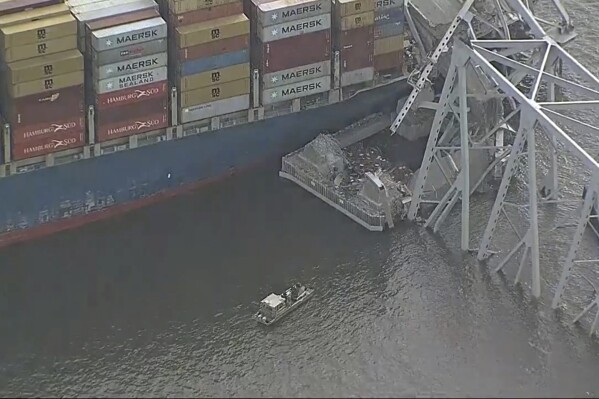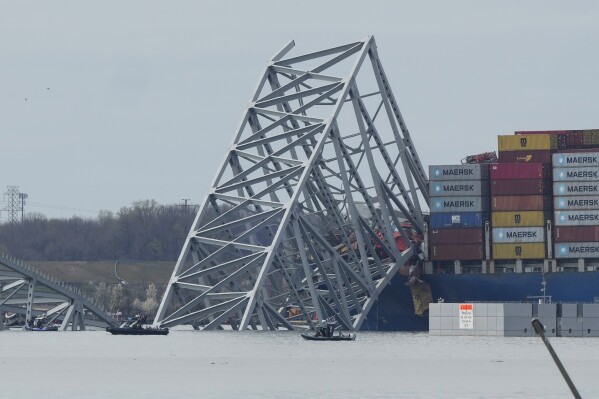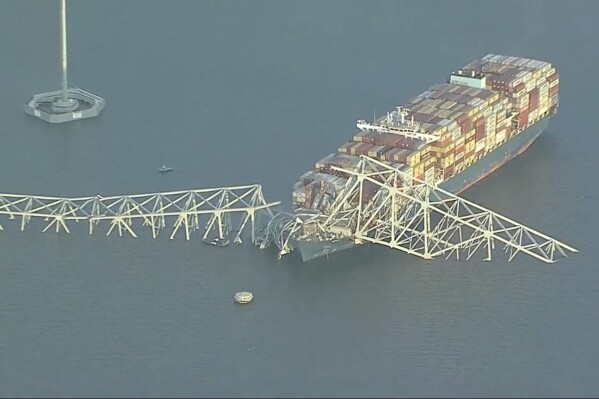Named for Star Spangled Banner author, the Francis Scott Key Bridge was part of Baltimore’s identity
The bridge that collapsed into a Maryland river after a ship strike Tuesday was iconic — erected almost five decades ago, named after the author of the Star Spangled Banner, and part of the very fabric of Baltimore.
Built near the spot where Francis Scott Key witnessed the bombardment of a fort that inspired what would become America’s national anthem, the namesake bridge collapsed into the Patapsco River after being struck by a ship that reported losing power just before the crash. Rescue crews were looking for six people who remained unaccounted for Tuesday afternoon.
“The words ‘the Key Bridge is gone,’ it’s still sinking in,” said Maryland Gov. Wes Moore. “For 47 years, that’s all we’ve known. It’s not just unprecedented; it’s heartbreaking.”
Moore said the bridge was “a normal commuting route for 30,000 Marylanders every day.” It had 185 feet of clearance above the water and was a key cog in the region’s transportation infrastructure.
David Belew, a vice president of the Maryland Center for History and Culture, said the Francis Scott Key Bridge was visible from Baltimore’s downtown office towers and “became inextricably linked with our sense of place, a part of commuters’ daily routines and an artery for commerce.”



“Our harbor, port and many families are fundamentally changed,” he said.
Designed as an outer crossing of the Baltimore Harbor, the 1.6-mile (2.57-kilometer) bridge opened on March 23, 1977, as the final link in I-695, known locally as the Baltimore Beltway.
The bridge came within 100 yards (91.44 meters) of where Key witnessed the British bombardment of Fort McHenry on Sept. 12, 1814, according to the Maryland Transportation Authority.
Key stood on the deck of an American ship in the Patapsco and watched Britain’s 25-hour assault on the fort. The raising of the American flag afterward inspired him to write the poem “The Defense of Fort M’Henry,” according to the National Parks Service. Set to music, it became the national anthem in 1931.
In the early 1960s, the Baltimore Harbor Tunnel (Interstate 895) had reached its traffic capacity, and motorists encountered heavy congestion and delays almost daily during rush hours, the transit agency wrote on its website. Plans were formulated for a second tunnel, but construction bids came in substantially higher than expected, and focus shifted to construction of a bridge.
The benefits of the plan were numerous: additional traffic capacity, lower maintenance costs, and the ability to handle vehicles carrying hazardous materials, which are prohibited in the tunnel.
Construction began in 1972, and the four-lane span opened five years later. The arched steel bridge most recently handled about 11.3 million vehicles a year.
“From the city of Baltimore’s perspective, it was instrumental in providing an alternative to the tunnel for traffic,” said Reuben Hull, a civil engineering historian.
With a main span of 1,200 feet (365.76 meters), it was the second-longest continuous truss bridge in the world when it opened, and it remained the second longest in the United States and third in the world, according to the American Society of Civil Engineers. It had a total length of 8,636 feet (2,632.25 meters).
Its condition before the collapse was rated as “fair,” according to the Federal Highway Administration’s 2023 National Bridge Inventory released last June. Inspectors rated its deck, substructure and superstructure — the component that absorbs the live traffic load — as “satisfactory.”
It is not to be confused with a similarly named six-lane bridge bringing U.S. Route 29 traffic across the Potomac River between Rosslyn, Virginia and the Georgetown neighborhood of Washington, D.C.
Anita Kassof, executive director of the Baltimore Museum of Industry, said the choice of Key as the bridge’s namesake honors the city’s toughness and perseverance in the face of tragedy.
“The Star Spangled Banner is an anthem to American resiliency, and Baltimore is a very resilient city,” she said. “We’ve been through a lot and we’ve gotten through a lot, and we’ll get through this, too.”
___
Follow Wayne Parry on X, formerly Twitter, at www.twitter.com/WayneParryAC
Disclaimer: The copyright of this article belongs to the original author. Reposting this article is solely for the purpose of information dissemination and does not constitute any investment advice. If there is any infringement, please contact us immediately. We will make corrections or deletions as necessary. Thank you.


